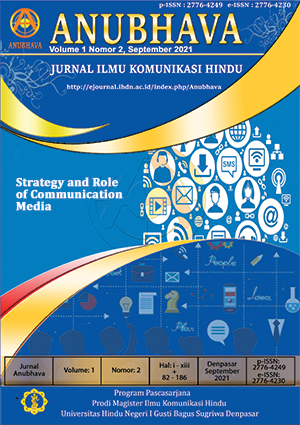KOMUNIKASI TRANSENDENTAL DALAM PEMENTASAN TARI SANG HYANG LEGONG KERATON LASEM PADA UPACARA TUMPEK WAYANG DI BANJAR ABIANNANGKA KAJA DENPASAR
DOI:
https://doi.org/10.25078/anubhava.v1i2.1077Keywords:
Transcendental Communication, Sang Hyang Legong Keraton at Lasem Palace, Tumpek Wayang, Banjar Abiannangka KajaAbstract
Dance is one of the arts that is quite easy to find in Bali, because many dances are performed as entertainment and are used in religious ceremonies in Bali. One of the classical dances that is sacred and performed during the tumpek wayang ceremony at Banjar Abiannangka Kaja is the Sang Hyang Legong Dance at the Lasem Keraton . Banjar Abiannangka Kaja believes that the dance performance can bring prosperity and is a way of communicating with Ida Sang Hyang Widhi Wasa, who in this case manifests as Ratu Ayu Alit Mas Suci who resides at the Banjar Temple. The formulation of the problem in this article is (1) the existence of the Sang Hyang Legong dance at the Lasem Keraton at the Tumpek wayang ceremony (2) the form of transcendental communication in the Sang Hyang Legong dance performance at the Lasem Keraton (3) the implications of transcendental communication on people's lives after performing the Sang Hyang Legong dance. Keraton Lasem The theories used to analyze the three problem formulations in this study are (1) Theory of Religion, (2) Theory of Extraordinary Powers and (3) Theory of Symbolic Interaction. This study uses a qualitative method. The results of this study indicate several things, such as: First, this Legong dance performance still survives today because it is believed to expel negative forces and can bring prosperity. Second, there are two forms of transcendental communication in this dance performance, namely the type of verbal communication (Pedudusan Sang Hyang Dedari singing, sesontengan and mantra) and the type of nonverbal communication (banten and dance movements). In this type of verbal and non-verbal communication, there is transcendental communication between humans and God from every meaning contained in songs, mantras, offerings and movements, both expressed and implied. Third, the implications for people's lives such as in religious life, social life, culture and the teachings of Tri Hita Karana.
References
Wiana, I Ketut, 2006. Beragama Bukan Hanya di Pura, Denpasar : Yayasan Dharma Naradha
Muhammad Fathurrohman. 2015. “Budaya Religius dalam Peningkatan Mutu Pendidikan: Tinjauan Teoritik dan Praktik Kontekstualisasi Pendidikan Agama Islam di Sekolahâ€. Yogyakarta: Kalimedia
Roibin. 2009. “Relasi Agama dan Budaya Masyarakat Kontemporerâ€. Malang: UIN Maliki Press.
Bandem, I Made, 1997. Ensiklopedi Musik dan Tari Daerah Bali Denpasar: Proyek Penelitian dan Pencatatan Kebudayaan Daerah Departemen Pendidikan dan Kebudayaan.
Jazuli, M. 2016. “Peta Dunia Seni Tariâ€. Sukoharjo: CV. Farishma Indonesia.
Yudabakti, I Made dan Watra, I Wayan. 2007. “Filsafat Seni Sakral dalam Kebudayaan Baliâ€. Surabaya: Paramitha.
Deddy Mulyana. 2001. “Ilmu Komunikasi Suatu Pengantar, Cet. XIVâ€. Bandung: PT. Remaja Rosdakarya
Suranto, Aw. 2011. Komunikasi Interpersonal. Yogyakarta : Graha Ilmu
Downloads
Published
Issue
Section
License

This work is licensed under a Creative Commons Attribution-NonCommercial-NoDerivatives 4.0 International License.
Anubhava: Jurnal Komunikasi Hindu is licensed under a Creative Commons Attribution-ShareAlike 4.0 International License. Permissions beyond the scope of this license may be available at Anubhava: Jurnal Ilmu Komunikasi
















